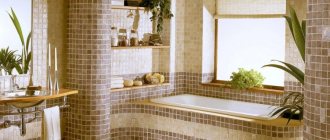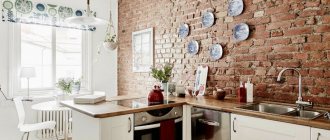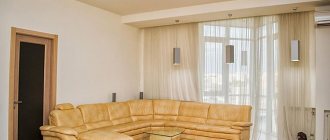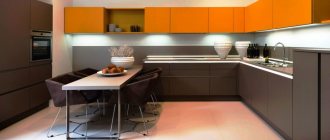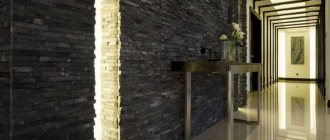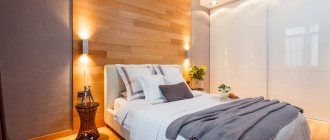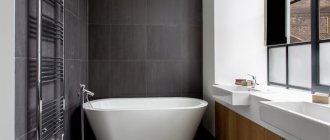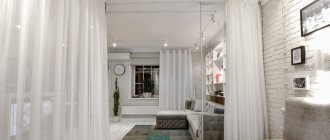Decorating walls with stone is an original way to decorate an apartment. Use it in combination with wallpaper or paint for an original effect. Read our article to learn how to choose a stone for your wall. We will advise which layout styles are best suited for this type of finish.
What will you read about in the article?
- Decorating walls with stone - pros and cons
- Stone walls of the hall - what material to choose?
- Stone on the wall in the living room - what to use?
- Which stone to choose for the wall in the kitchen?
- Is rock on the bathroom wall a good idea?
- Plaster and concrete stone for the wall - is it worth it?
Decorating walls with stone - pros and cons
A stone for the wall will allow you to get an unusual location. Thanks to the material, you can add variety to your decor - all you have to do is apply it to one wall. An entire room covered in stone can have an overwhelming effect, especially in a small interior.
Stone for the wall can be combined with both wallpaper and paintwork. It all depends on what design style you plan to use in the interior. The advantage of decorative stone for walls is that it works well in both dry and wet areas. Don't worry, use it in the bathroom or kitchen - with proper protection, it will be resistant to moisture and dirt.
The stone for the wall will act as sound insulation. This makes it ideal for homes with small children. The material also protects against dirt - it is more resistant than wallpaper or a painted surface. The stone wall is also insensitive to mechanical damage.
A stone on the wall is not a solution without flaws. Price can be an issue for many planning a renovation. Natural raw materials even cost several thousand rubles per m2.
The cost of a stone wall increases the need to hire specialists for assembly. With painting or wallpaper, most people can handle it themselves, but in the case of natural raw materials it is better not to take risks. A stone that is not properly glued to the wall may fall and this is dangerous.
Stone for a wall - is it worth it?
- Natural material diversifies the appearance of the interior,
- Looks good in combination with wallpaper and a wall covered with paint,
- Works great in dry and damp areas,
- Isolates sounds good
- Expensive,
- Installation must be done by a specialist, which further increases costs.
Leaving visible stone in an old home will highlight the rustic look of the interior.
Technology of facing work
To prevent natural stone from falling off during operation, a number of rules must be followed when installing it:
. It should be as smooth and even as possible. There should be no debris on it that will interfere with proper adhesion.
Before laying the stone, be sure to prepare the surface- Use a deep penetration primer . Apply it in 2-3 layers to previously prepared surfaces.
- After priming, use plaster . It is also applied in 2-3 layers. After this, a reinforcing mesh and 2 more layers of plaster are laid out on the surface. This way the walls are strengthened. Do not forget that natural stone has an impressive weight, especially when used in large quantities.
- Don't forget about waterproofing . This measure is necessary if the stone is used for cladding a room with high humidity, for example, a bathroom.
- Lay out the drawing on the floor . Before attaching the stones to the surface, place them on the floor or any other hard surface in the desired order. This way you will get a high-quality pattern the first time and you won’t have to tear the stone off the wall.
- Decide on the fixation method . The stone can be laid in a joint or with a gap between the seams. In this case, it all depends on the type of stone and the desired decorative effect.
Laying method
The prepared adhesive solution is taken with a spatula or spatula and applied to the center of the tile. After this, the stone is pressed against the prepared surface and rotated a little so that the solution is evenly distributed between the tile and the wall. After this, the stone is pressed firmly and held for several seconds to achieve better adhesion.
Make sure that the glue you choose fully matches the type of stone you use. Be sure to study the characteristics of the solution before purchasing.
Installation work is carried out from top to bottom. In simple words, if you are working on walls, you need to start from the ceiling. This will allow you to achieve the most natural result.
If you decide to lay stone tiles with a joint, be sure to use tile crosses. They will help ensure even gaps between all slabs. When the tiles are completely dry, you can start grouting the joints.
Stone walls in the hall - what material to choose?
The hall is the space that guests see first. The interior is a preview of the style that was used throughout the rest of the house, so it pays to use quality materials. The corridor is especially susceptible to contamination, for example by sand or wet clothes. A stone room can be comfortable and maintain its aesthetic appearance for a long time - all you need to do is choose the right material.
The stone in the hallway should be light in color because this space usually has little access to natural light. A suitable material would be sandstone, which is commonly used as a flooring material. The stone comes in different colors and depends on where it is mined. However, the most popular colors of sandstone are beige and brown, which are ideal as decorative stone for a hallway.
Slate will also work as stone in a hallway. If the hall in your home has access to natural light and is spacious, choose black tiles. It will look great in an interior decorated in Scandinavian and modern style.
A corridor made of stone with slate in the main role will be not only stylish, but also convenient to use. Don't be afraid of black tiles because the raw material has the advantage of not fading. The attractive decorative stone for the hall is also stain and water resistant. Its durability is evidenced by the fact that it is often used as flooring on the veranda.
Using slate in the interior
Stone wall - what material to choose?
- Sandstone is ideal for the hallway, which comes in different colors, but the most popular are beige and brown,
- Slate is also suitable as a stone in the hall; if you have a spacious hallway, choose the black option, which looks modern,
- Slate is resistant to dirt and moisture and does not fade,
- A small hallway without access to natural light will benefit from bright sandstone tiles.
Natural stone on the walls will be ideal in a large hall
General characteristics
Any stone has a lot of weight.
This ensures its increased strength and reliability. However, this same point complicates the installation process. The surface to be finished must be well prepared, and the solution used must have increased adhesive ability. The main characteristics of natural stones are:
- Fire resistance . The material can be used to finish surfaces that may overheat during operation.
- Moisture resistance . Stone is an ideal solution for decorating a bathroom, sauna, kitchen or any other room with high humidity.
- Resistant to aggressive liquids . Natural stone is not afraid of the effects of acids, alkalis, and fats.
- Good sound and heat insulation properties . By finishing the walls with stone you can achieve good sound insulation or increase the level of heat retention in the house.
- Environmental friendliness . This is a natural material that allows you to maintain a natural indoor microclimate.
- UV resistance . The design on the stone does not fade over time.
Expert opinion
Mezentsev Sergey Petrovich
Residential renovation and finishing specialist
Stone cladding inside a room always increases the status of a home. It is not necessary to choose very expensive breeds. There are natural stones on the market that have a fairly affordable price.
Stone on the wall in the living room - what to use?
There is another room in the living room that would work great with a stone wall. Thanks to the material, you can vary the location - just use the material on the wall behind the TV. You can also use stone on the wall in the living room in the sitting area next to the sofas. The material will be combined with both wallpaper and paintwork.
A living room with stone walls can be used in a modern, elegant or classic style. All you have to do is choose your marble. The material is more suitable for a dry room because it is sensitive to moisture and stains.
Marble in the living room interior
In fact, marble is limestone in which chemical processes took place. It comes in a variety of colors, but the most popular is white with black streaks. This option will look great in a minimalist space when paired with white paint. The stone wall in the living room can also be black with light veining - this option will look good only in a spacious room.
Travertine in the interior
A stone wall in a living room doesn't have to be made of marble, which gives a pretty cool effect. Travertine in warm colors will also work. This wall stone will look great in both classic and modern designs.
Travertine is resistant to damage. The stone is also distinguished by a large number of channels and deep recesses. Travertine is suitable for dry areas because it has a high level of water absorption. It is better not to use it in the bathroom, but you can use it in the living room decor without fear - it can decorate not only the wall, but also the fireplace.
Introduction
Natural materials - wood, clay and, of course, stone - have firmly established themselves in home decoration long before the concept of interior design appeared. And if earlier the choice was determined by such material qualities as strength and durability, now visual characteristics are on a par with them.
Decorating walls and floors with decorative stone
A wide choice of colors, textures and formats makes decorative stone one of the most popular materials in interior and exterior decoration. The floor, walls or figured masonry of the fireplace made of natural and artificial stone add a touch of luxury to the room, emphasizing the style and individuality of the interior of an apartment or private house.
To determine which type of stone is right for you, you need to understand the range and qualities of a particular material. So what kind of stone is used in interior decoration?
Which stone to choose for the wall in the kitchen?
Stone walls will show themselves not only in dry rooms, but also in the kitchen. The interior is exposed to moisture, changing temperatures and various types of dirt, so it requires high-quality wall cladding. Granite, that is, a volcanic rock, will ideally serve as a decorative stone for a kitchen wall.
Granite is the hardest stone, resistant to abrasion. It is also insensitive to chemicals, so it can be used on kitchen countertops. Remember that granite is a heavy material, so it requires a strong foundation. Due to its resistance to moisture and abrasion, the stone is ideal for the kitchen between wall-mounted and standing cabinets.
Granite comes in different colors so you can easily integrate it into your interior design idea. You will find tiles in warm and cool shades. You can combine stone on your kitchen wall with a worktop made of the same material to create a space that is resistant to stains, moisture and damage.
Stone wall in the kitchen - what material to choose?
- Granite is ideal for the kitchen,
- The stone is characterized by hardness, abrasion resistance and resistance to cleaning agents,
- The raw materials are also resistant to moisture,
- You can apply it both to the countertop and to the wall between hanging and standing cabinets - this way you will get a uniform surface,
- Granite is available in various shades, such as brown or aqua.
Kitchen wall cladding can provide an elegant backdrop for a table area.
Photo gallery - even more ideas
In the photo selection below you will see how else you can use decorative stone in the interior. The gallery of images includes the most interesting design solutions for finishing stairs, niches and arches.
Sources
- https://m-strana.ru/design/sposoby-ispolzovaniya-dekorativnogo-kamnya-v-interere/
- https://ReHouz.info/dekorativnyj-kamen-v-interere-foto/
- https://www.InMyRoom.ru/posts/16103-dekorativnyj-kamen-v-interere-s-foto
- https://www.dizainvfoto.ru/dekor/dekorativnyj-kamen-v-interere-vse-sekrety-izyskannoj-otdelki.html
- https://design-homes.ru/idei-dlya-doma/ispolzovanie-kamnya-v-interere-kvartiry-vidy-sochetaniya-65-foto
- https://stroyday.ru/remont-kvartiry/steny-i-potolok/iskusstvennyj-kamen-v-interere.html
- https://ars.ru/vnutrennyaya-otdelka-pod-kamen-v-raznyh-komnatah/
- https://J.Etagi.com/ps/otdelka-dekorativnym-kamnem/
- https://www.ivd.ru/dizajn-i-dekor/dekorirovanie/7-tipov-iskusstvennogo-i-naturalnogo-kamnya-i-nyuansy-ih-ispolzovaniya-v-interere-35451
- https://Trizio.ru/dekorativniy-kamen-v-interere-foto-20
Is rock on the bathroom wall a good idea?
The most popular way to decorate a bathroom is to use ceramic tiles . If you want a more elegant effect, choose natural stone for the wall. You can apply it throughout the room - all it needs is the right saturation. With stone you can also highlight a part of the interior, such as a shower stall, in which you can apply a different material from the other walls in the bathroom.
A suitable finishing material for a bathroom would be granite, which copes well with moisture. You can apply limestone to the wall below the mirror, but remember that it requires soaking. It is soft and absorbs moisture. Limestone comes in a variety of shades, but is most often warm in color, so it will look great in a classic and cozy bathroom.
- Stone walls in the bathroom will look impressive and will retain their aesthetic appearance for a long time thanks to impregnation. Granite is suitable for this room, Limestone is also suitable, but it must be properly protected so as not to absorb moisture.
Moisture-resistant stone can be successfully used on bathroom walls
Color spectrum
There is a large number of color palettes for decorative stonework. Experts advise us to use this or that color depending on the parameters of the room: area, availability of lighting, busy interior. White color is the leader in use in narrow, small corridors, hallways, and bathrooms. It creates a visual increase in the room. Warm shades and grays work well in larger spaces along with wooden materials.
Plaster and concrete stone for the wall - is it worth it?
Natural stone walls are an expensive solution. Want to enjoy impressive design without stretching your budget? Choose plaster or concrete decorative stone for the wall.
Gypsum tiles perfectly imitate natural raw materials and are much cheaper. This type of wall cladding works well in dry areas because it is sensitive to moisture. Gypsum tiles can be painted in any color, resulting in an unusual effect.
You can also use architectural concrete instead of natural stone. This method of wall decoration is ideal for raw interiors, such as industrial and minimalist ones. Unlike gypsum concrete slabs, you will also be using them in areas that are exposed to high levels of humidity.
Why choose us for interior decoration?
The Stoneproduct company provides turnkey interior finishing with natural stone: from the development of a unique design project to the installation of slabs on site. You should trust us with natural stone finishing in Moscow because:
- we have our own production base equipped with modern equipment;
- We carry out calculations, select materials, provide consultations on the features of use and properties of products;
- We always have a large selection of stone for wall cladding;
- We have affordable prices for stone finishing;
- We provide a two-year warranty on all work and products.
